Economics for Business: A Case Study of Cadbury
VerifiedAdded on 2023/06/18
|13
|3162
|74
AI Summary
This report explores the role of economics in business decision-making through a case study of Cadbury, the world's largest confectionery business. It covers their mission, vision, pricing strategies, and the impact of fiscal and monetary policies on their operations.
Contribute Materials
Your contribution can guide someone’s learning journey. Share your
documents today.
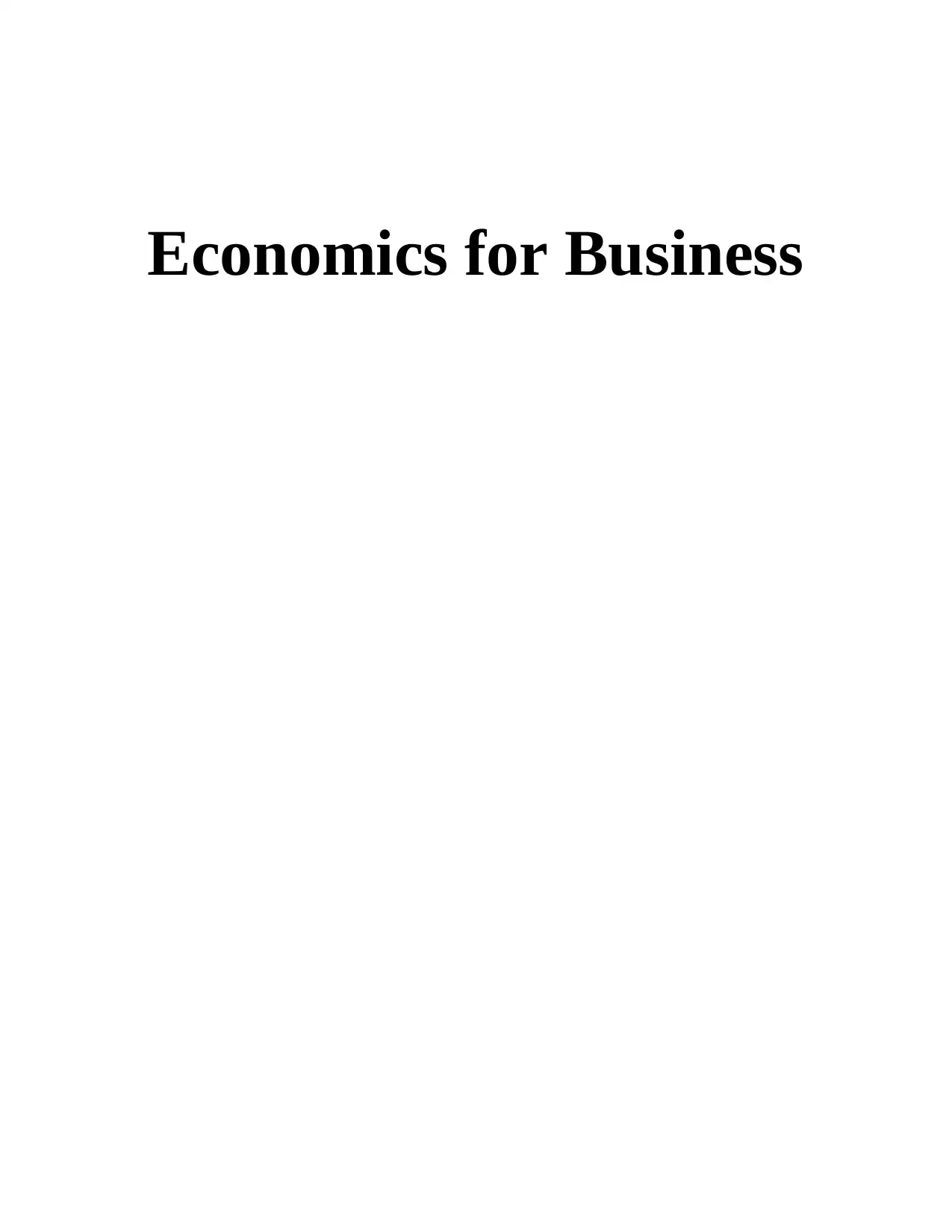
Economics for Business
Secure Best Marks with AI Grader
Need help grading? Try our AI Grader for instant feedback on your assignments.

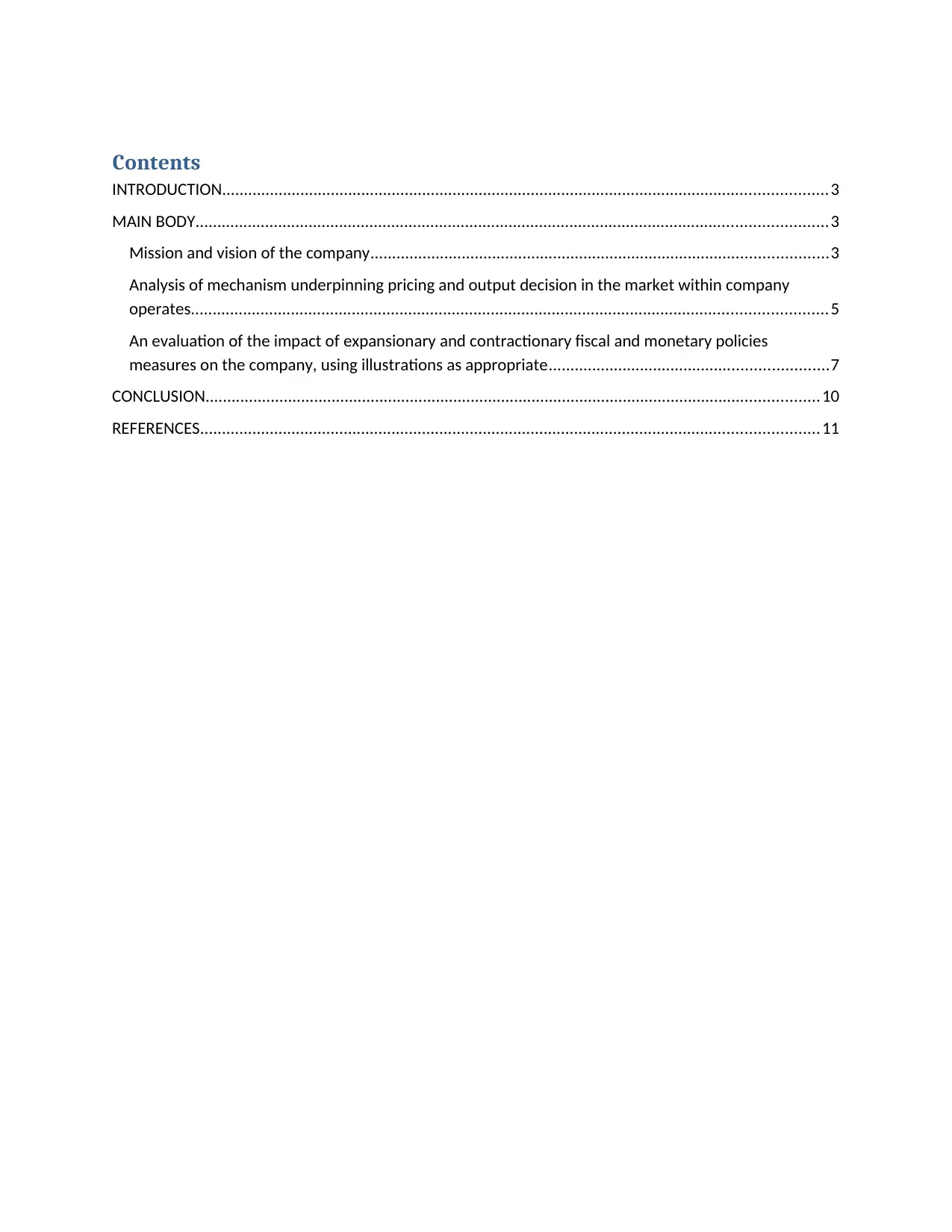
Contents
INTRODUCTION...........................................................................................................................................3
MAIN BODY.................................................................................................................................................3
Mission and vision of the company.........................................................................................................3
Analysis of mechanism underpinning pricing and output decision in the market within company
operates..................................................................................................................................................5
An evaluation of the impact of expansionary and contractionary fiscal and monetary policies
measures on the company, using illustrations as appropriate................................................................7
CONCLUSION.............................................................................................................................................10
REFERENCES..............................................................................................................................................11
INTRODUCTION...........................................................................................................................................3
MAIN BODY.................................................................................................................................................3
Mission and vision of the company.........................................................................................................3
Analysis of mechanism underpinning pricing and output decision in the market within company
operates..................................................................................................................................................5
An evaluation of the impact of expansionary and contractionary fiscal and monetary policies
measures on the company, using illustrations as appropriate................................................................7
CONCLUSION.............................................................................................................................................10
REFERENCES..............................................................................................................................................11
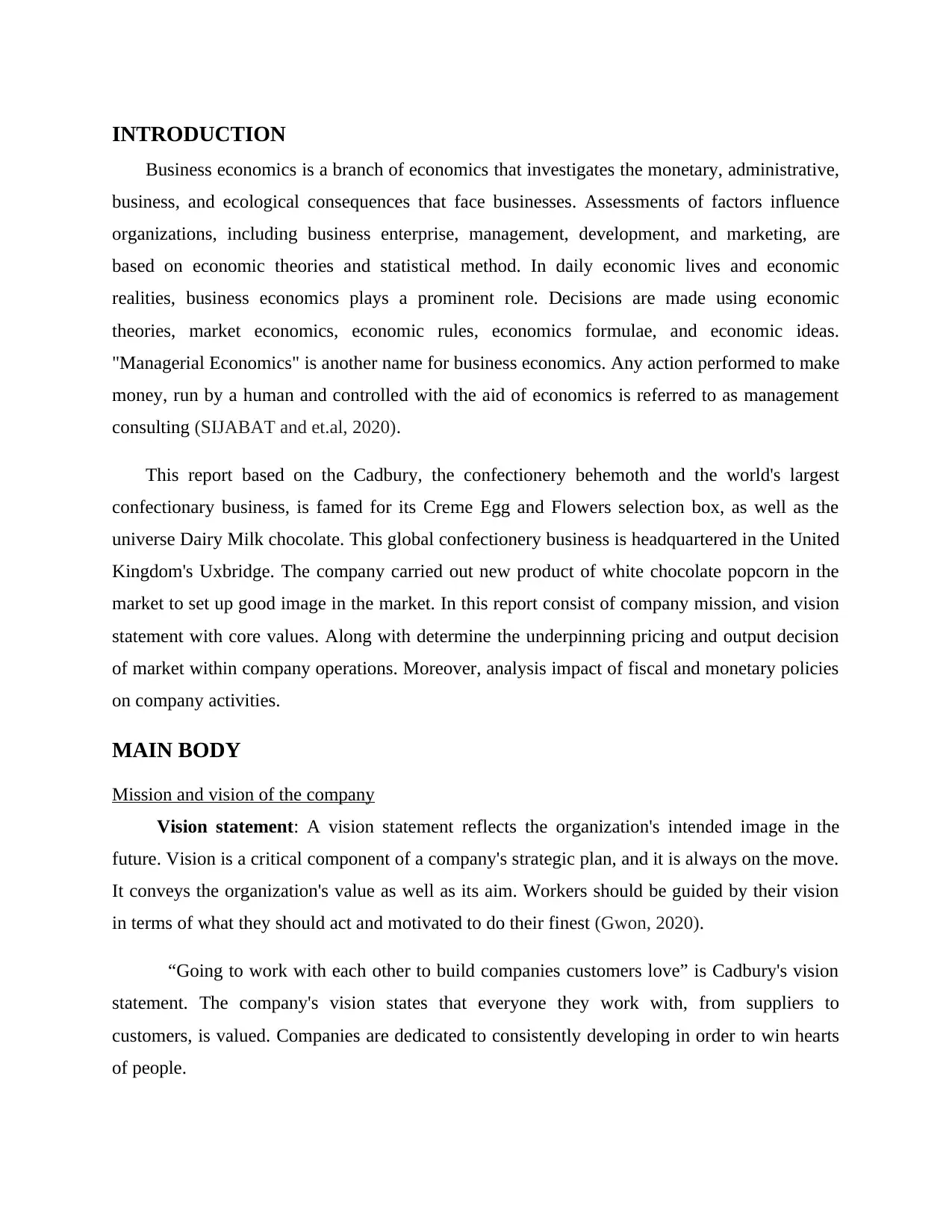
INTRODUCTION
Business economics is a branch of economics that investigates the monetary, administrative,
business, and ecological consequences that face businesses. Assessments of factors influence
organizations, including business enterprise, management, development, and marketing, are
based on economic theories and statistical method. In daily economic lives and economic
realities, business economics plays a prominent role. Decisions are made using economic
theories, market economics, economic rules, economics formulae, and economic ideas.
"Managerial Economics" is another name for business economics. Any action performed to make
money, run by a human and controlled with the aid of economics is referred to as management
consulting (SIJABAT and et.al, 2020).
This report based on the Cadbury, the confectionery behemoth and the world's largest
confectionary business, is famed for its Creme Egg and Flowers selection box, as well as the
universe Dairy Milk chocolate. This global confectionery business is headquartered in the United
Kingdom's Uxbridge. The company carried out new product of white chocolate popcorn in the
market to set up good image in the market. In this report consist of company mission, and vision
statement with core values. Along with determine the underpinning pricing and output decision
of market within company operations. Moreover, analysis impact of fiscal and monetary policies
on company activities.
MAIN BODY
Mission and vision of the company
Vision statement: A vision statement reflects the organization's intended image in the
future. Vision is a critical component of a company's strategic plan, and it is always on the move.
It conveys the organization's value as well as its aim. Workers should be guided by their vision
in terms of what they should act and motivated to do their finest (Gwon, 2020).
“Going to work with each other to build companies customers love” is Cadbury's vision
statement. The company's vision states that everyone they work with, from suppliers to
customers, is valued. Companies are dedicated to consistently developing in order to win hearts
of people.
Business economics is a branch of economics that investigates the monetary, administrative,
business, and ecological consequences that face businesses. Assessments of factors influence
organizations, including business enterprise, management, development, and marketing, are
based on economic theories and statistical method. In daily economic lives and economic
realities, business economics plays a prominent role. Decisions are made using economic
theories, market economics, economic rules, economics formulae, and economic ideas.
"Managerial Economics" is another name for business economics. Any action performed to make
money, run by a human and controlled with the aid of economics is referred to as management
consulting (SIJABAT and et.al, 2020).
This report based on the Cadbury, the confectionery behemoth and the world's largest
confectionary business, is famed for its Creme Egg and Flowers selection box, as well as the
universe Dairy Milk chocolate. This global confectionery business is headquartered in the United
Kingdom's Uxbridge. The company carried out new product of white chocolate popcorn in the
market to set up good image in the market. In this report consist of company mission, and vision
statement with core values. Along with determine the underpinning pricing and output decision
of market within company operations. Moreover, analysis impact of fiscal and monetary policies
on company activities.
MAIN BODY
Mission and vision of the company
Vision statement: A vision statement reflects the organization's intended image in the
future. Vision is a critical component of a company's strategic plan, and it is always on the move.
It conveys the organization's value as well as its aim. Workers should be guided by their vision
in terms of what they should act and motivated to do their finest (Gwon, 2020).
“Going to work with each other to build companies customers love” is Cadbury's vision
statement. The company's vision states that everyone they work with, from suppliers to
customers, is valued. Companies are dedicated to consistently developing in order to win hearts
of people.
Secure Best Marks with AI Grader
Need help grading? Try our AI Grader for instant feedback on your assignments.
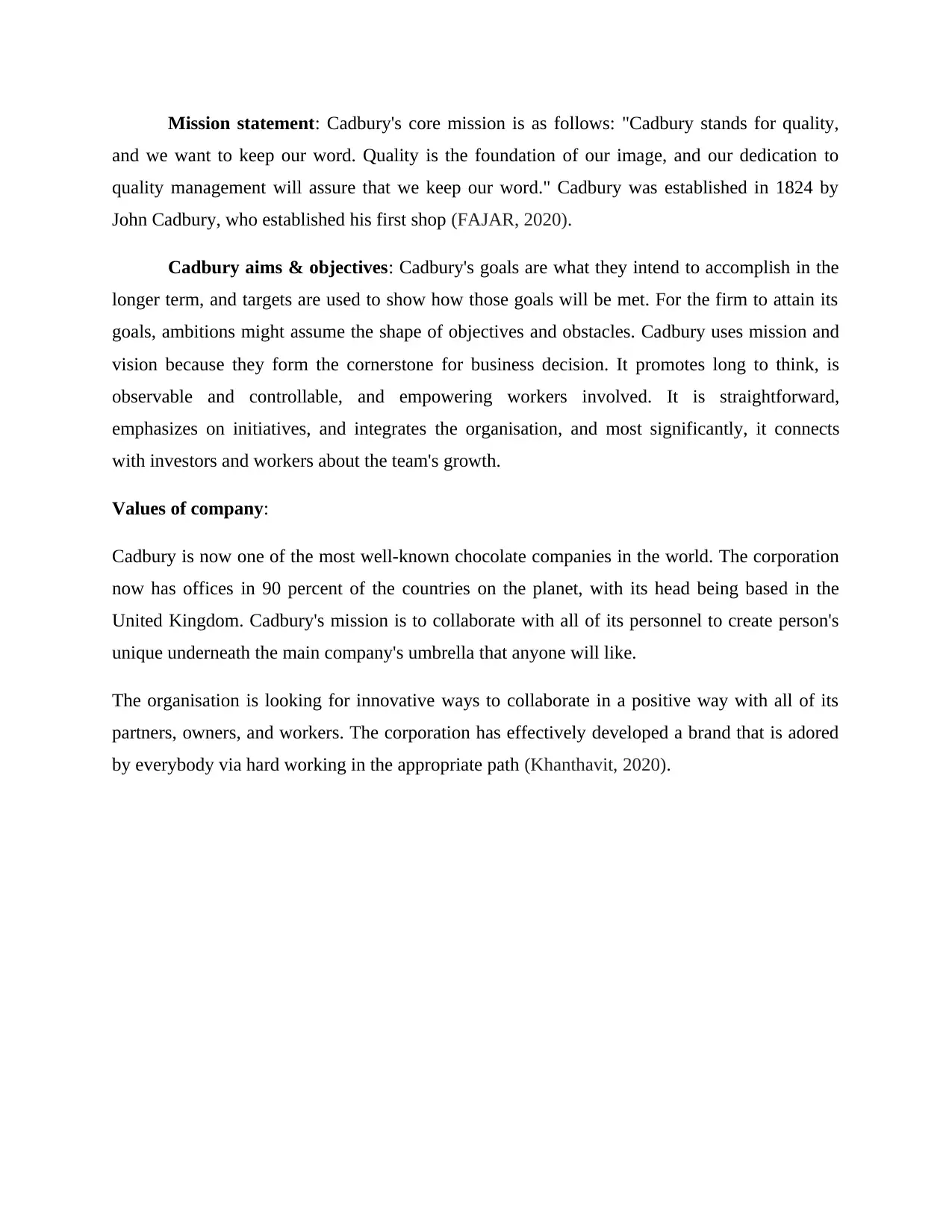
Mission statement: Cadbury's core mission is as follows: "Cadbury stands for quality,
and we want to keep our word. Quality is the foundation of our image, and our dedication to
quality management will assure that we keep our word." Cadbury was established in 1824 by
John Cadbury, who established his first shop (FAJAR, 2020).
Cadbury aims & objectives: Cadbury's goals are what they intend to accomplish in the
longer term, and targets are used to show how those goals will be met. For the firm to attain its
goals, ambitions might assume the shape of objectives and obstacles. Cadbury uses mission and
vision because they form the cornerstone for business decision. It promotes long to think, is
observable and controllable, and empowering workers involved. It is straightforward,
emphasizes on initiatives, and integrates the organisation, and most significantly, it connects
with investors and workers about the team's growth.
Values of company:
Cadbury is now one of the most well-known chocolate companies in the world. The corporation
now has offices in 90 percent of the countries on the planet, with its head being based in the
United Kingdom. Cadbury's mission is to collaborate with all of its personnel to create person's
unique underneath the main company's umbrella that anyone will like.
The organisation is looking for innovative ways to collaborate in a positive way with all of its
partners, owners, and workers. The corporation has effectively developed a brand that is adored
by everybody via hard working in the appropriate path (Khanthavit, 2020).
and we want to keep our word. Quality is the foundation of our image, and our dedication to
quality management will assure that we keep our word." Cadbury was established in 1824 by
John Cadbury, who established his first shop (FAJAR, 2020).
Cadbury aims & objectives: Cadbury's goals are what they intend to accomplish in the
longer term, and targets are used to show how those goals will be met. For the firm to attain its
goals, ambitions might assume the shape of objectives and obstacles. Cadbury uses mission and
vision because they form the cornerstone for business decision. It promotes long to think, is
observable and controllable, and empowering workers involved. It is straightforward,
emphasizes on initiatives, and integrates the organisation, and most significantly, it connects
with investors and workers about the team's growth.
Values of company:
Cadbury is now one of the most well-known chocolate companies in the world. The corporation
now has offices in 90 percent of the countries on the planet, with its head being based in the
United Kingdom. Cadbury's mission is to collaborate with all of its personnel to create person's
unique underneath the main company's umbrella that anyone will like.
The organisation is looking for innovative ways to collaborate in a positive way with all of its
partners, owners, and workers. The corporation has effectively developed a brand that is adored
by everybody via hard working in the appropriate path (Khanthavit, 2020).
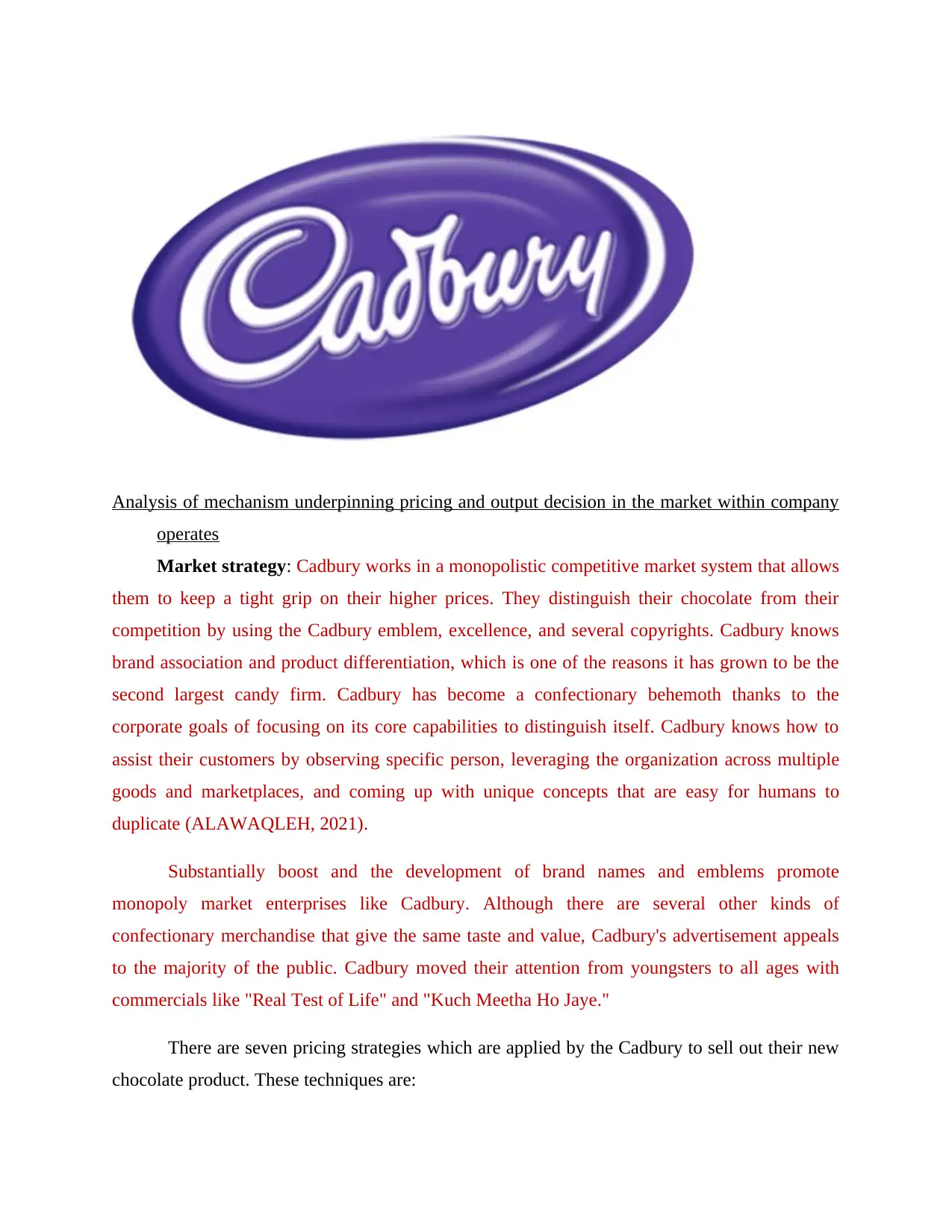
Analysis of mechanism underpinning pricing and output decision in the market within company
operates
Market strategy: Cadbury works in a monopolistic competitive market system that allows
them to keep a tight grip on their higher prices. They distinguish their chocolate from their
competition by using the Cadbury emblem, excellence, and several copyrights. Cadbury knows
brand association and product differentiation, which is one of the reasons it has grown to be the
second largest candy firm. Cadbury has become a confectionary behemoth thanks to the
corporate goals of focusing on its core capabilities to distinguish itself. Cadbury knows how to
assist their customers by observing specific person, leveraging the organization across multiple
goods and marketplaces, and coming up with unique concepts that are easy for humans to
duplicate (ALAWAQLEH, 2021).
Substantially boost and the development of brand names and emblems promote
monopoly market enterprises like Cadbury. Although there are several other kinds of
confectionary merchandise that give the same taste and value, Cadbury's advertisement appeals
to the majority of the public. Cadbury moved their attention from youngsters to all ages with
commercials like "Real Test of Life" and "Kuch Meetha Ho Jaye."
There are seven pricing strategies which are applied by the Cadbury to sell out their new
chocolate product. These techniques are:
operates
Market strategy: Cadbury works in a monopolistic competitive market system that allows
them to keep a tight grip on their higher prices. They distinguish their chocolate from their
competition by using the Cadbury emblem, excellence, and several copyrights. Cadbury knows
brand association and product differentiation, which is one of the reasons it has grown to be the
second largest candy firm. Cadbury has become a confectionary behemoth thanks to the
corporate goals of focusing on its core capabilities to distinguish itself. Cadbury knows how to
assist their customers by observing specific person, leveraging the organization across multiple
goods and marketplaces, and coming up with unique concepts that are easy for humans to
duplicate (ALAWAQLEH, 2021).
Substantially boost and the development of brand names and emblems promote
monopoly market enterprises like Cadbury. Although there are several other kinds of
confectionary merchandise that give the same taste and value, Cadbury's advertisement appeals
to the majority of the public. Cadbury moved their attention from youngsters to all ages with
commercials like "Real Test of Life" and "Kuch Meetha Ho Jaye."
There are seven pricing strategies which are applied by the Cadbury to sell out their new
chocolate product. These techniques are:
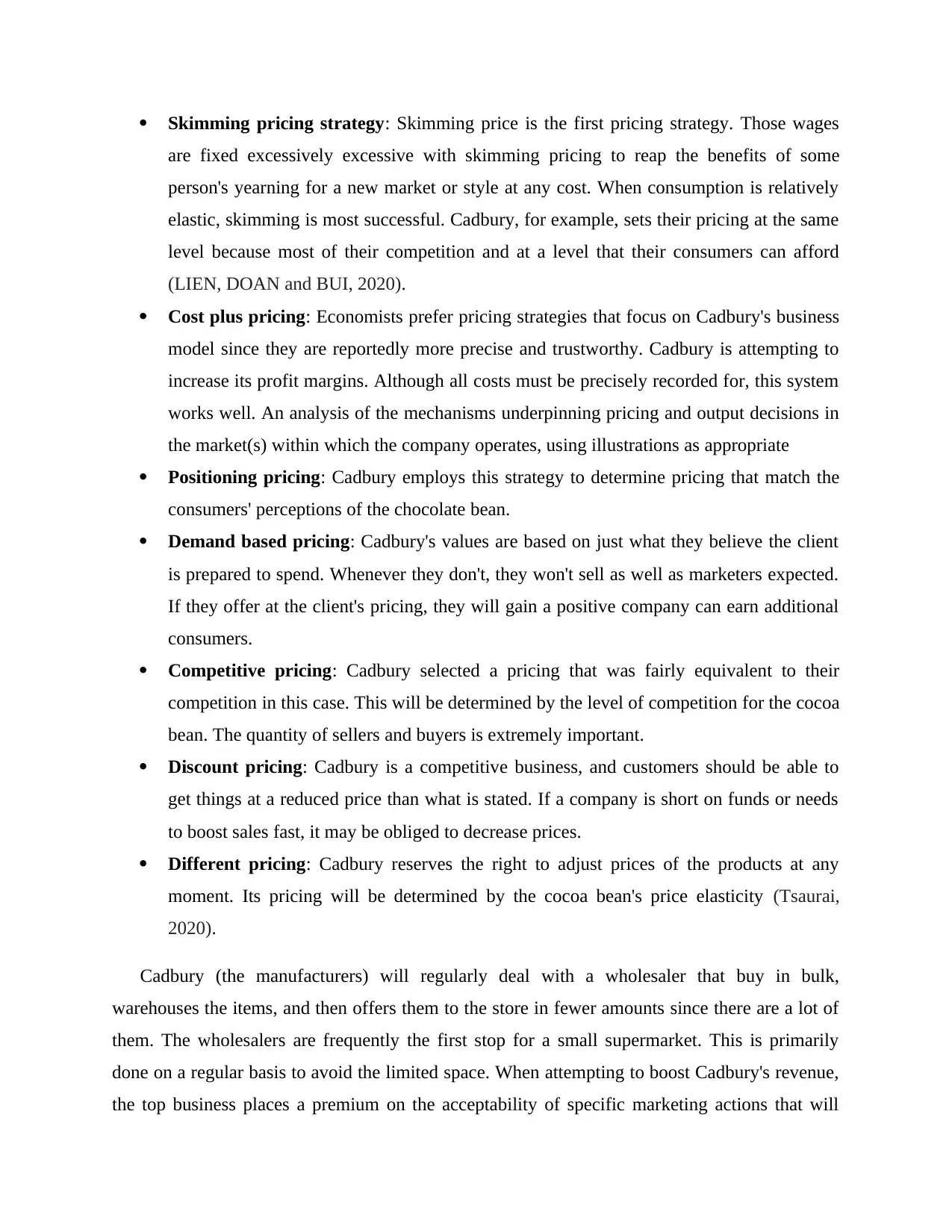
Skimming pricing strategy: Skimming price is the first pricing strategy. Those wages
are fixed excessively excessive with skimming pricing to reap the benefits of some
person's yearning for a new market or style at any cost. When consumption is relatively
elastic, skimming is most successful. Cadbury, for example, sets their pricing at the same
level because most of their competition and at a level that their consumers can afford
(LIEN, DOAN and BUI, 2020).
Cost plus pricing: Economists prefer pricing strategies that focus on Cadbury's business
model since they are reportedly more precise and trustworthy. Cadbury is attempting to
increase its profit margins. Although all costs must be precisely recorded for, this system
works well. An analysis of the mechanisms underpinning pricing and output decisions in
the market(s) within which the company operates, using illustrations as appropriate
Positioning pricing: Cadbury employs this strategy to determine pricing that match the
consumers' perceptions of the chocolate bean.
Demand based pricing: Cadbury's values are based on just what they believe the client
is prepared to spend. Whenever they don't, they won't sell as well as marketers expected.
If they offer at the client's pricing, they will gain a positive company can earn additional
consumers.
Competitive pricing: Cadbury selected a pricing that was fairly equivalent to their
competition in this case. This will be determined by the level of competition for the cocoa
bean. The quantity of sellers and buyers is extremely important.
Discount pricing: Cadbury is a competitive business, and customers should be able to
get things at a reduced price than what is stated. If a company is short on funds or needs
to boost sales fast, it may be obliged to decrease prices.
Different pricing: Cadbury reserves the right to adjust prices of the products at any
moment. Its pricing will be determined by the cocoa bean's price elasticity (Tsaurai,
2020).
Cadbury (the manufacturers) will regularly deal with a wholesaler that buy in bulk,
warehouses the items, and then offers them to the store in fewer amounts since there are a lot of
them. The wholesalers are frequently the first stop for a small supermarket. This is primarily
done on a regular basis to avoid the limited space. When attempting to boost Cadbury's revenue,
the top business places a premium on the acceptability of specific marketing actions that will
are fixed excessively excessive with skimming pricing to reap the benefits of some
person's yearning for a new market or style at any cost. When consumption is relatively
elastic, skimming is most successful. Cadbury, for example, sets their pricing at the same
level because most of their competition and at a level that their consumers can afford
(LIEN, DOAN and BUI, 2020).
Cost plus pricing: Economists prefer pricing strategies that focus on Cadbury's business
model since they are reportedly more precise and trustworthy. Cadbury is attempting to
increase its profit margins. Although all costs must be precisely recorded for, this system
works well. An analysis of the mechanisms underpinning pricing and output decisions in
the market(s) within which the company operates, using illustrations as appropriate
Positioning pricing: Cadbury employs this strategy to determine pricing that match the
consumers' perceptions of the chocolate bean.
Demand based pricing: Cadbury's values are based on just what they believe the client
is prepared to spend. Whenever they don't, they won't sell as well as marketers expected.
If they offer at the client's pricing, they will gain a positive company can earn additional
consumers.
Competitive pricing: Cadbury selected a pricing that was fairly equivalent to their
competition in this case. This will be determined by the level of competition for the cocoa
bean. The quantity of sellers and buyers is extremely important.
Discount pricing: Cadbury is a competitive business, and customers should be able to
get things at a reduced price than what is stated. If a company is short on funds or needs
to boost sales fast, it may be obliged to decrease prices.
Different pricing: Cadbury reserves the right to adjust prices of the products at any
moment. Its pricing will be determined by the cocoa bean's price elasticity (Tsaurai,
2020).
Cadbury (the manufacturers) will regularly deal with a wholesaler that buy in bulk,
warehouses the items, and then offers them to the store in fewer amounts since there are a lot of
them. The wholesalers are frequently the first stop for a small supermarket. This is primarily
done on a regular basis to avoid the limited space. When attempting to boost Cadbury's revenue,
the top business places a premium on the acceptability of specific marketing actions that will
Paraphrase This Document
Need a fresh take? Get an instant paraphrase of this document with our AI Paraphraser
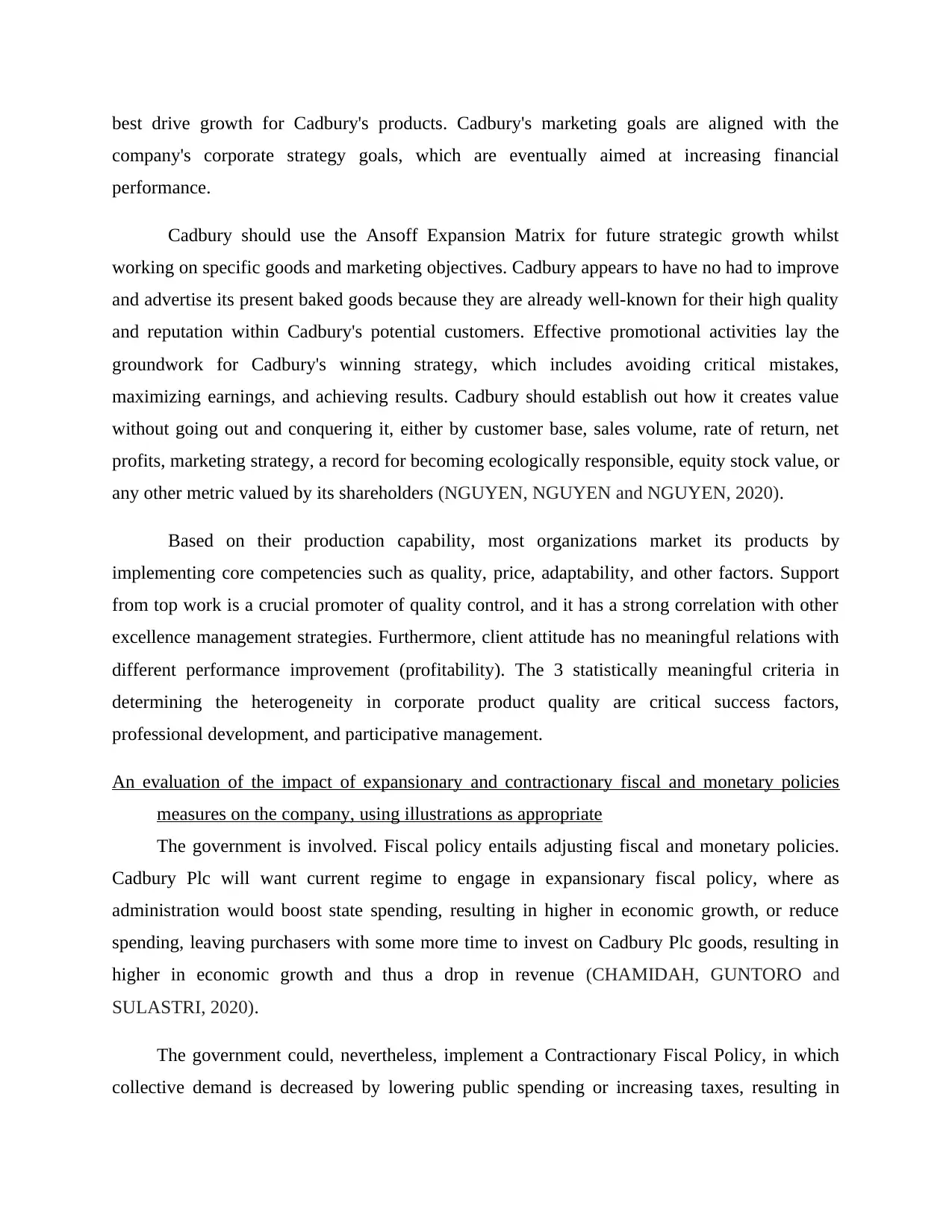
best drive growth for Cadbury's products. Cadbury's marketing goals are aligned with the
company's corporate strategy goals, which are eventually aimed at increasing financial
performance.
Cadbury should use the Ansoff Expansion Matrix for future strategic growth whilst
working on specific goods and marketing objectives. Cadbury appears to have no had to improve
and advertise its present baked goods because they are already well-known for their high quality
and reputation within Cadbury's potential customers. Effective promotional activities lay the
groundwork for Cadbury's winning strategy, which includes avoiding critical mistakes,
maximizing earnings, and achieving results. Cadbury should establish out how it creates value
without going out and conquering it, either by customer base, sales volume, rate of return, net
profits, marketing strategy, a record for becoming ecologically responsible, equity stock value, or
any other metric valued by its shareholders (NGUYEN, NGUYEN and NGUYEN, 2020).
Based on their production capability, most organizations market its products by
implementing core competencies such as quality, price, adaptability, and other factors. Support
from top work is a crucial promoter of quality control, and it has a strong correlation with other
excellence management strategies. Furthermore, client attitude has no meaningful relations with
different performance improvement (profitability). The 3 statistically meaningful criteria in
determining the heterogeneity in corporate product quality are critical success factors,
professional development, and participative management.
An evaluation of the impact of expansionary and contractionary fiscal and monetary policies
measures on the company, using illustrations as appropriate
The government is involved. Fiscal policy entails adjusting fiscal and monetary policies.
Cadbury Plc will want current regime to engage in expansionary fiscal policy, where as
administration would boost state spending, resulting in higher in economic growth, or reduce
spending, leaving purchasers with some more time to invest on Cadbury Plc goods, resulting in
higher in economic growth and thus a drop in revenue (CHAMIDAH, GUNTORO and
SULASTRI, 2020).
The government could, nevertheless, implement a Contractionary Fiscal Policy, in which
collective demand is decreased by lowering public spending or increasing taxes, resulting in
company's corporate strategy goals, which are eventually aimed at increasing financial
performance.
Cadbury should use the Ansoff Expansion Matrix for future strategic growth whilst
working on specific goods and marketing objectives. Cadbury appears to have no had to improve
and advertise its present baked goods because they are already well-known for their high quality
and reputation within Cadbury's potential customers. Effective promotional activities lay the
groundwork for Cadbury's winning strategy, which includes avoiding critical mistakes,
maximizing earnings, and achieving results. Cadbury should establish out how it creates value
without going out and conquering it, either by customer base, sales volume, rate of return, net
profits, marketing strategy, a record for becoming ecologically responsible, equity stock value, or
any other metric valued by its shareholders (NGUYEN, NGUYEN and NGUYEN, 2020).
Based on their production capability, most organizations market its products by
implementing core competencies such as quality, price, adaptability, and other factors. Support
from top work is a crucial promoter of quality control, and it has a strong correlation with other
excellence management strategies. Furthermore, client attitude has no meaningful relations with
different performance improvement (profitability). The 3 statistically meaningful criteria in
determining the heterogeneity in corporate product quality are critical success factors,
professional development, and participative management.
An evaluation of the impact of expansionary and contractionary fiscal and monetary policies
measures on the company, using illustrations as appropriate
The government is involved. Fiscal policy entails adjusting fiscal and monetary policies.
Cadbury Plc will want current regime to engage in expansionary fiscal policy, where as
administration would boost state spending, resulting in higher in economic growth, or reduce
spending, leaving purchasers with some more time to invest on Cadbury Plc goods, resulting in
higher in economic growth and thus a drop in revenue (CHAMIDAH, GUNTORO and
SULASTRI, 2020).
The government could, nevertheless, implement a Contractionary Fiscal Policy, in which
collective demand is decreased by lowering public spending or increasing taxes, resulting in
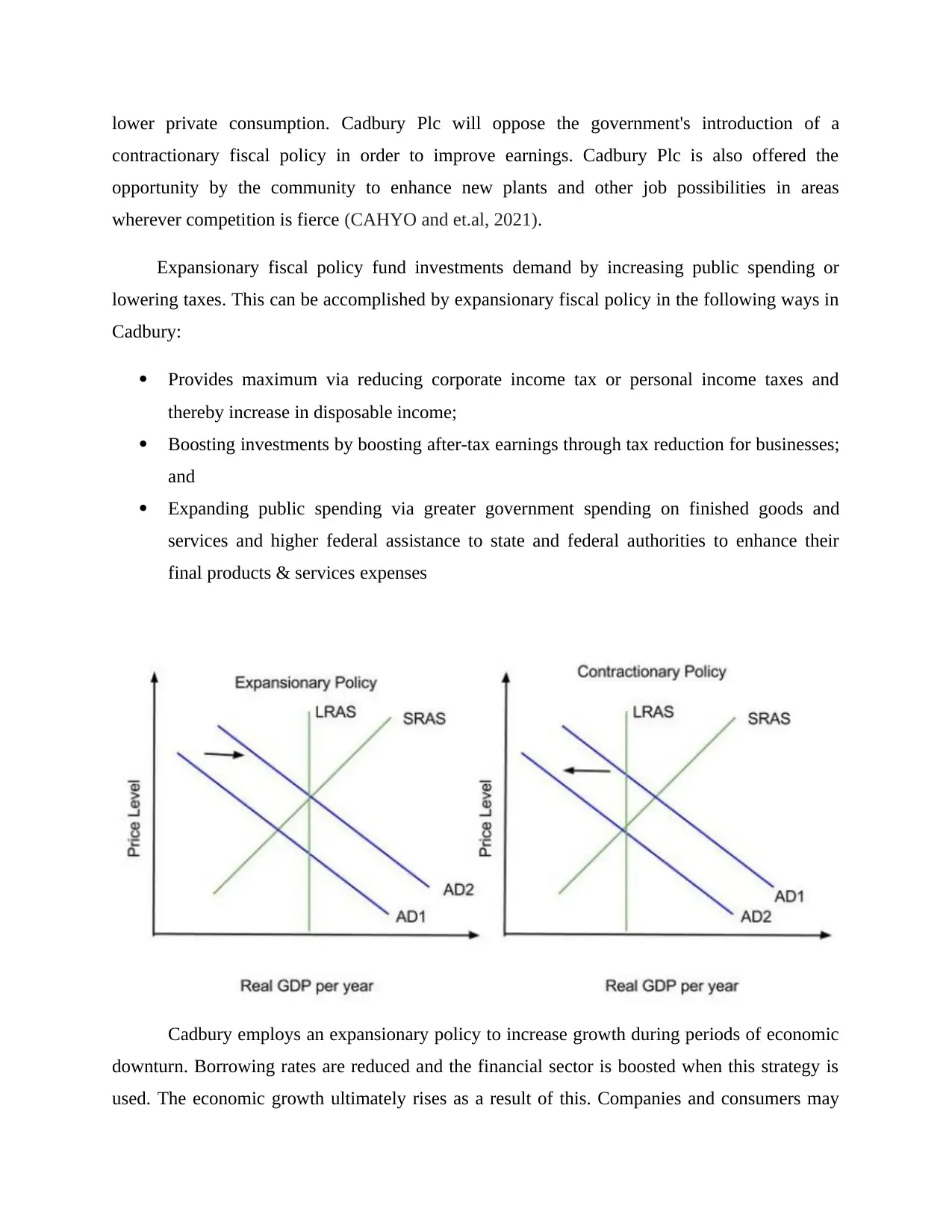
lower private consumption. Cadbury Plc will oppose the government's introduction of a
contractionary fiscal policy in order to improve earnings. Cadbury Plc is also offered the
opportunity by the community to enhance new plants and other job possibilities in areas
wherever competition is fierce (CAHYO and et.al, 2021).
Expansionary fiscal policy fund investments demand by increasing public spending or
lowering taxes. This can be accomplished by expansionary fiscal policy in the following ways in
Cadbury:
Provides maximum via reducing corporate income tax or personal income taxes and
thereby increase in disposable income;
Boosting investments by boosting after-tax earnings through tax reduction for businesses;
and
Expanding public spending via greater government spending on finished goods and
services and higher federal assistance to state and federal authorities to enhance their
final products & services expenses
Cadbury employs an expansionary policy to increase growth during periods of economic
downturn. Borrowing rates are reduced and the financial sector is boosted when this strategy is
used. The economic growth ultimately rises as a result of this. Companies and consumers may
contractionary fiscal policy in order to improve earnings. Cadbury Plc is also offered the
opportunity by the community to enhance new plants and other job possibilities in areas
wherever competition is fierce (CAHYO and et.al, 2021).
Expansionary fiscal policy fund investments demand by increasing public spending or
lowering taxes. This can be accomplished by expansionary fiscal policy in the following ways in
Cadbury:
Provides maximum via reducing corporate income tax or personal income taxes and
thereby increase in disposable income;
Boosting investments by boosting after-tax earnings through tax reduction for businesses;
and
Expanding public spending via greater government spending on finished goods and
services and higher federal assistance to state and federal authorities to enhance their
final products & services expenses
Cadbury employs an expansionary policy to increase growth during periods of economic
downturn. Borrowing rates are reduced and the financial sector is boosted when this strategy is
used. The economic growth ultimately rises as a result of this. Companies and consumers may
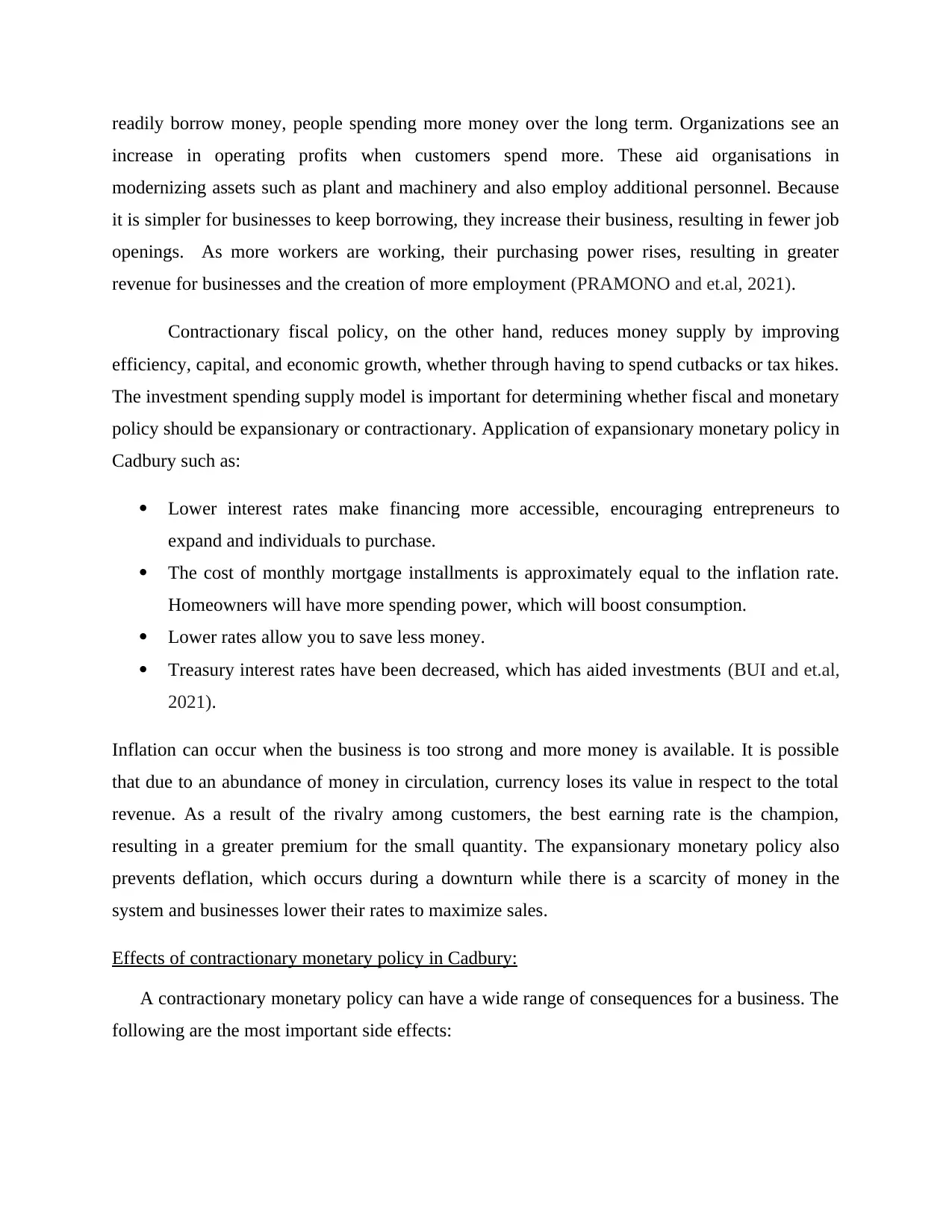
readily borrow money, people spending more money over the long term. Organizations see an
increase in operating profits when customers spend more. These aid organisations in
modernizing assets such as plant and machinery and also employ additional personnel. Because
it is simpler for businesses to keep borrowing, they increase their business, resulting in fewer job
openings. As more workers are working, their purchasing power rises, resulting in greater
revenue for businesses and the creation of more employment (PRAMONO and et.al, 2021).
Contractionary fiscal policy, on the other hand, reduces money supply by improving
efficiency, capital, and economic growth, whether through having to spend cutbacks or tax hikes.
The investment spending supply model is important for determining whether fiscal and monetary
policy should be expansionary or contractionary. Application of expansionary monetary policy in
Cadbury such as:
Lower interest rates make financing more accessible, encouraging entrepreneurs to
expand and individuals to purchase.
The cost of monthly mortgage installments is approximately equal to the inflation rate.
Homeowners will have more spending power, which will boost consumption.
Lower rates allow you to save less money.
Treasury interest rates have been decreased, which has aided investments (BUI and et.al,
2021).
Inflation can occur when the business is too strong and more money is available. It is possible
that due to an abundance of money in circulation, currency loses its value in respect to the total
revenue. As a result of the rivalry among customers, the best earning rate is the champion,
resulting in a greater premium for the small quantity. The expansionary monetary policy also
prevents deflation, which occurs during a downturn while there is a scarcity of money in the
system and businesses lower their rates to maximize sales.
Effects of contractionary monetary policy in Cadbury:
A contractionary monetary policy can have a wide range of consequences for a business. The
following are the most important side effects:
increase in operating profits when customers spend more. These aid organisations in
modernizing assets such as plant and machinery and also employ additional personnel. Because
it is simpler for businesses to keep borrowing, they increase their business, resulting in fewer job
openings. As more workers are working, their purchasing power rises, resulting in greater
revenue for businesses and the creation of more employment (PRAMONO and et.al, 2021).
Contractionary fiscal policy, on the other hand, reduces money supply by improving
efficiency, capital, and economic growth, whether through having to spend cutbacks or tax hikes.
The investment spending supply model is important for determining whether fiscal and monetary
policy should be expansionary or contractionary. Application of expansionary monetary policy in
Cadbury such as:
Lower interest rates make financing more accessible, encouraging entrepreneurs to
expand and individuals to purchase.
The cost of monthly mortgage installments is approximately equal to the inflation rate.
Homeowners will have more spending power, which will boost consumption.
Lower rates allow you to save less money.
Treasury interest rates have been decreased, which has aided investments (BUI and et.al,
2021).
Inflation can occur when the business is too strong and more money is available. It is possible
that due to an abundance of money in circulation, currency loses its value in respect to the total
revenue. As a result of the rivalry among customers, the best earning rate is the champion,
resulting in a greater premium for the small quantity. The expansionary monetary policy also
prevents deflation, which occurs during a downturn while there is a scarcity of money in the
system and businesses lower their rates to maximize sales.
Effects of contractionary monetary policy in Cadbury:
A contractionary monetary policy can have a wide range of consequences for a business. The
following are the most important side effects:
Secure Best Marks with AI Grader
Need help grading? Try our AI Grader for instant feedback on your assignments.
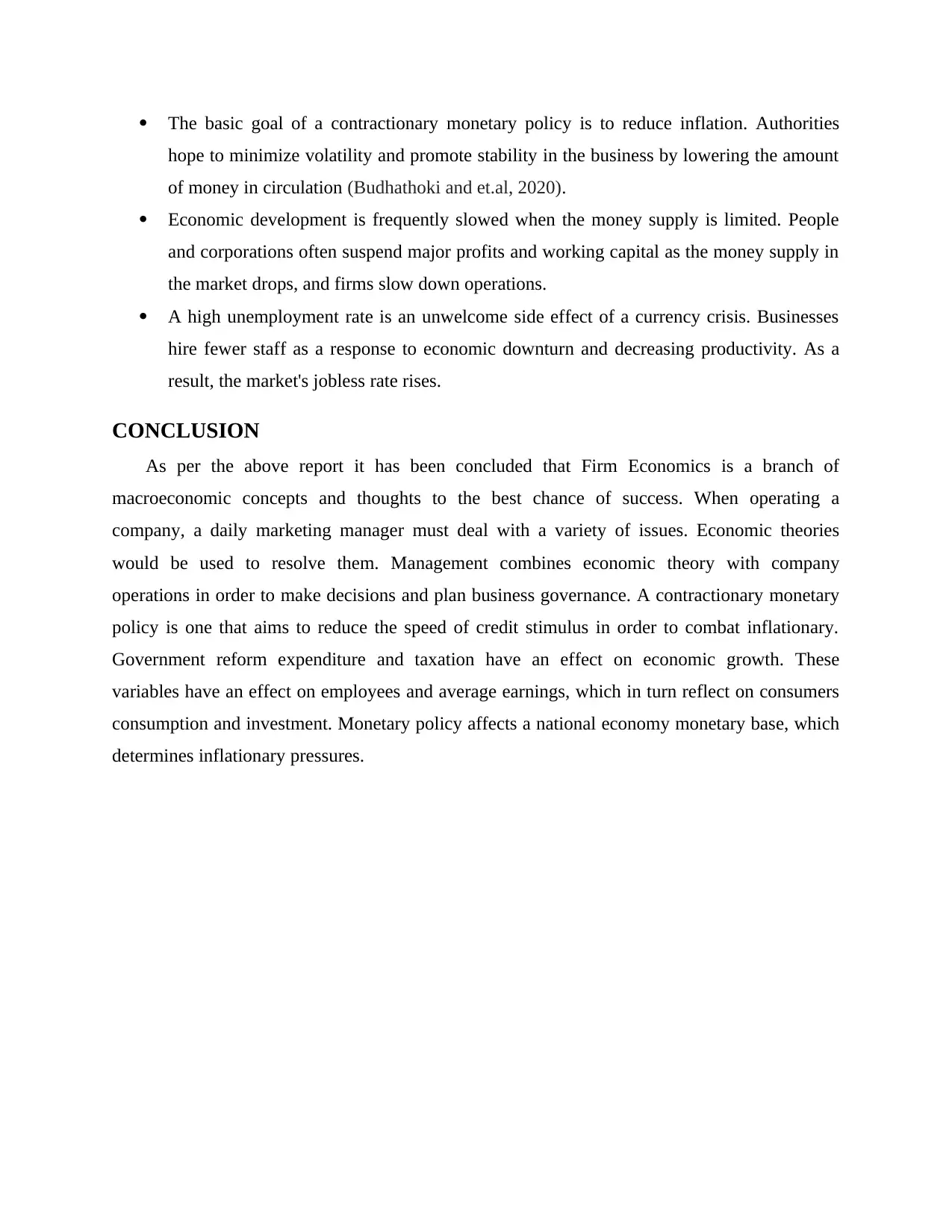
The basic goal of a contractionary monetary policy is to reduce inflation. Authorities
hope to minimize volatility and promote stability in the business by lowering the amount
of money in circulation (Budhathoki and et.al, 2020).
Economic development is frequently slowed when the money supply is limited. People
and corporations often suspend major profits and working capital as the money supply in
the market drops, and firms slow down operations.
A high unemployment rate is an unwelcome side effect of a currency crisis. Businesses
hire fewer staff as a response to economic downturn and decreasing productivity. As a
result, the market's jobless rate rises.
CONCLUSION
As per the above report it has been concluded that Firm Economics is a branch of
macroeconomic concepts and thoughts to the best chance of success. When operating a
company, a daily marketing manager must deal with a variety of issues. Economic theories
would be used to resolve them. Management combines economic theory with company
operations in order to make decisions and plan business governance. A contractionary monetary
policy is one that aims to reduce the speed of credit stimulus in order to combat inflationary.
Government reform expenditure and taxation have an effect on economic growth. These
variables have an effect on employees and average earnings, which in turn reflect on consumers
consumption and investment. Monetary policy affects a national economy monetary base, which
determines inflationary pressures.
hope to minimize volatility and promote stability in the business by lowering the amount
of money in circulation (Budhathoki and et.al, 2020).
Economic development is frequently slowed when the money supply is limited. People
and corporations often suspend major profits and working capital as the money supply in
the market drops, and firms slow down operations.
A high unemployment rate is an unwelcome side effect of a currency crisis. Businesses
hire fewer staff as a response to economic downturn and decreasing productivity. As a
result, the market's jobless rate rises.
CONCLUSION
As per the above report it has been concluded that Firm Economics is a branch of
macroeconomic concepts and thoughts to the best chance of success. When operating a
company, a daily marketing manager must deal with a variety of issues. Economic theories
would be used to resolve them. Management combines economic theory with company
operations in order to make decisions and plan business governance. A contractionary monetary
policy is one that aims to reduce the speed of credit stimulus in order to combat inflationary.
Government reform expenditure and taxation have an effect on economic growth. These
variables have an effect on employees and average earnings, which in turn reflect on consumers
consumption and investment. Monetary policy affects a national economy monetary base, which
determines inflationary pressures.
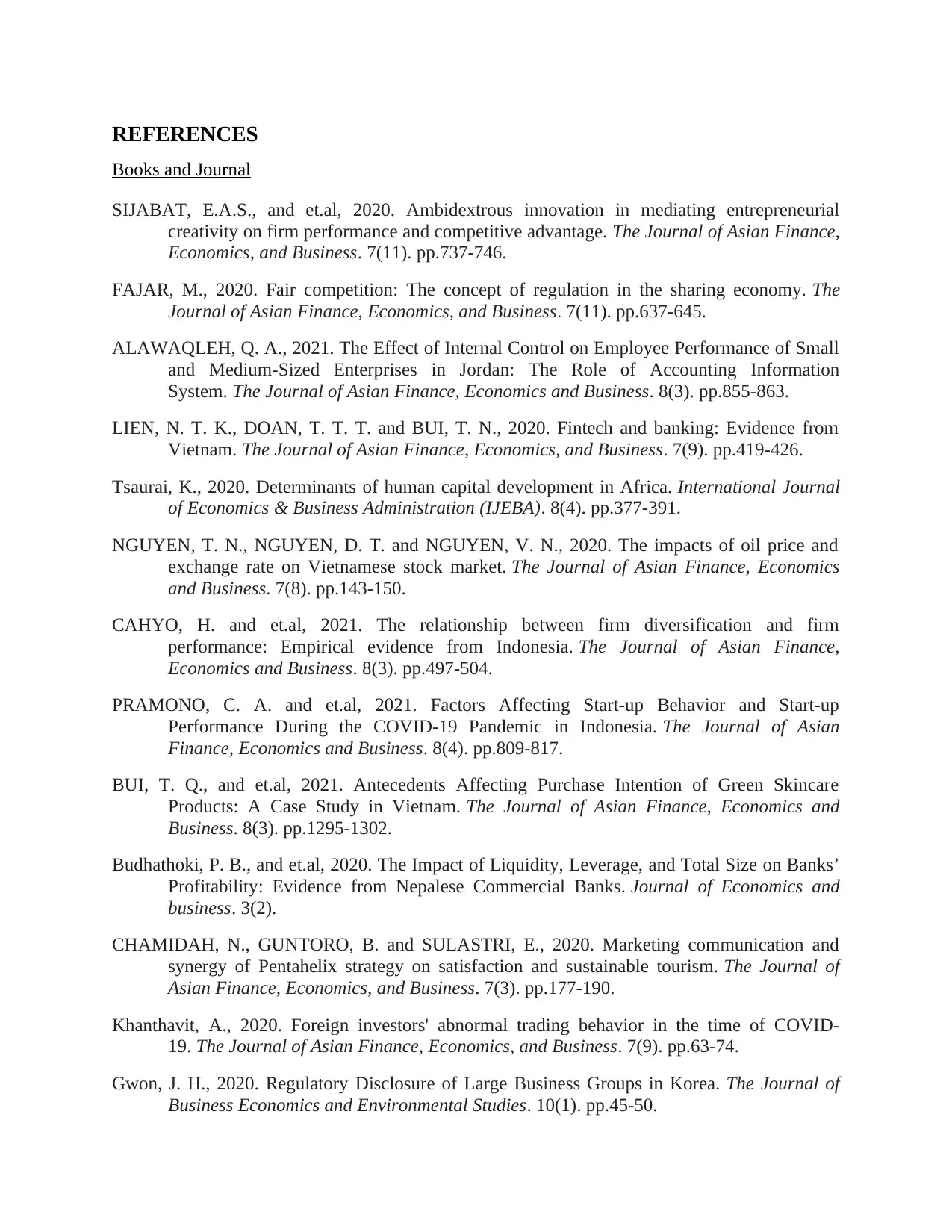
REFERENCES
Books and Journal
SIJABAT, E.A.S., and et.al, 2020. Ambidextrous innovation in mediating entrepreneurial
creativity on firm performance and competitive advantage. The Journal of Asian Finance,
Economics, and Business. 7(11). pp.737-746.
FAJAR, M., 2020. Fair competition: The concept of regulation in the sharing economy. The
Journal of Asian Finance, Economics, and Business. 7(11). pp.637-645.
ALAWAQLEH, Q. A., 2021. The Effect of Internal Control on Employee Performance of Small
and Medium-Sized Enterprises in Jordan: The Role of Accounting Information
System. The Journal of Asian Finance, Economics and Business. 8(3). pp.855-863.
LIEN, N. T. K., DOAN, T. T. T. and BUI, T. N., 2020. Fintech and banking: Evidence from
Vietnam. The Journal of Asian Finance, Economics, and Business. 7(9). pp.419-426.
Tsaurai, K., 2020. Determinants of human capital development in Africa. International Journal
of Economics & Business Administration (IJEBA). 8(4). pp.377-391.
NGUYEN, T. N., NGUYEN, D. T. and NGUYEN, V. N., 2020. The impacts of oil price and
exchange rate on Vietnamese stock market. The Journal of Asian Finance, Economics
and Business. 7(8). pp.143-150.
CAHYO, H. and et.al, 2021. The relationship between firm diversification and firm
performance: Empirical evidence from Indonesia. The Journal of Asian Finance,
Economics and Business. 8(3). pp.497-504.
PRAMONO, C. A. and et.al, 2021. Factors Affecting Start-up Behavior and Start-up
Performance During the COVID-19 Pandemic in Indonesia. The Journal of Asian
Finance, Economics and Business. 8(4). pp.809-817.
BUI, T. Q., and et.al, 2021. Antecedents Affecting Purchase Intention of Green Skincare
Products: A Case Study in Vietnam. The Journal of Asian Finance, Economics and
Business. 8(3). pp.1295-1302.
Budhathoki, P. B., and et.al, 2020. The Impact of Liquidity, Leverage, and Total Size on Banks’
Profitability: Evidence from Nepalese Commercial Banks. Journal of Economics and
business. 3(2).
CHAMIDAH, N., GUNTORO, B. and SULASTRI, E., 2020. Marketing communication and
synergy of Pentahelix strategy on satisfaction and sustainable tourism. The Journal of
Asian Finance, Economics, and Business. 7(3). pp.177-190.
Khanthavit, A., 2020. Foreign investors' abnormal trading behavior in the time of COVID-
19. The Journal of Asian Finance, Economics, and Business. 7(9). pp.63-74.
Gwon, J. H., 2020. Regulatory Disclosure of Large Business Groups in Korea. The Journal of
Business Economics and Environmental Studies. 10(1). pp.45-50.
Books and Journal
SIJABAT, E.A.S., and et.al, 2020. Ambidextrous innovation in mediating entrepreneurial
creativity on firm performance and competitive advantage. The Journal of Asian Finance,
Economics, and Business. 7(11). pp.737-746.
FAJAR, M., 2020. Fair competition: The concept of regulation in the sharing economy. The
Journal of Asian Finance, Economics, and Business. 7(11). pp.637-645.
ALAWAQLEH, Q. A., 2021. The Effect of Internal Control on Employee Performance of Small
and Medium-Sized Enterprises in Jordan: The Role of Accounting Information
System. The Journal of Asian Finance, Economics and Business. 8(3). pp.855-863.
LIEN, N. T. K., DOAN, T. T. T. and BUI, T. N., 2020. Fintech and banking: Evidence from
Vietnam. The Journal of Asian Finance, Economics, and Business. 7(9). pp.419-426.
Tsaurai, K., 2020. Determinants of human capital development in Africa. International Journal
of Economics & Business Administration (IJEBA). 8(4). pp.377-391.
NGUYEN, T. N., NGUYEN, D. T. and NGUYEN, V. N., 2020. The impacts of oil price and
exchange rate on Vietnamese stock market. The Journal of Asian Finance, Economics
and Business. 7(8). pp.143-150.
CAHYO, H. and et.al, 2021. The relationship between firm diversification and firm
performance: Empirical evidence from Indonesia. The Journal of Asian Finance,
Economics and Business. 8(3). pp.497-504.
PRAMONO, C. A. and et.al, 2021. Factors Affecting Start-up Behavior and Start-up
Performance During the COVID-19 Pandemic in Indonesia. The Journal of Asian
Finance, Economics and Business. 8(4). pp.809-817.
BUI, T. Q., and et.al, 2021. Antecedents Affecting Purchase Intention of Green Skincare
Products: A Case Study in Vietnam. The Journal of Asian Finance, Economics and
Business. 8(3). pp.1295-1302.
Budhathoki, P. B., and et.al, 2020. The Impact of Liquidity, Leverage, and Total Size on Banks’
Profitability: Evidence from Nepalese Commercial Banks. Journal of Economics and
business. 3(2).
CHAMIDAH, N., GUNTORO, B. and SULASTRI, E., 2020. Marketing communication and
synergy of Pentahelix strategy on satisfaction and sustainable tourism. The Journal of
Asian Finance, Economics, and Business. 7(3). pp.177-190.
Khanthavit, A., 2020. Foreign investors' abnormal trading behavior in the time of COVID-
19. The Journal of Asian Finance, Economics, and Business. 7(9). pp.63-74.
Gwon, J. H., 2020. Regulatory Disclosure of Large Business Groups in Korea. The Journal of
Business Economics and Environmental Studies. 10(1). pp.45-50.

1 out of 13
Related Documents
Your All-in-One AI-Powered Toolkit for Academic Success.
+13062052269
info@desklib.com
Available 24*7 on WhatsApp / Email
![[object Object]](/_next/static/media/star-bottom.7253800d.svg)
Unlock your academic potential
© 2024 | Zucol Services PVT LTD | All rights reserved.


![[PDF] Marketing Essentials Assignment : Cadbury](/_next/image/?url=https%3A%2F%2Fdesklib.com%2Fmedia%2Fimages%2Fcr%2F346f3b89017d49429de8c4689a89bbe1.jpg&w=256&q=75)


